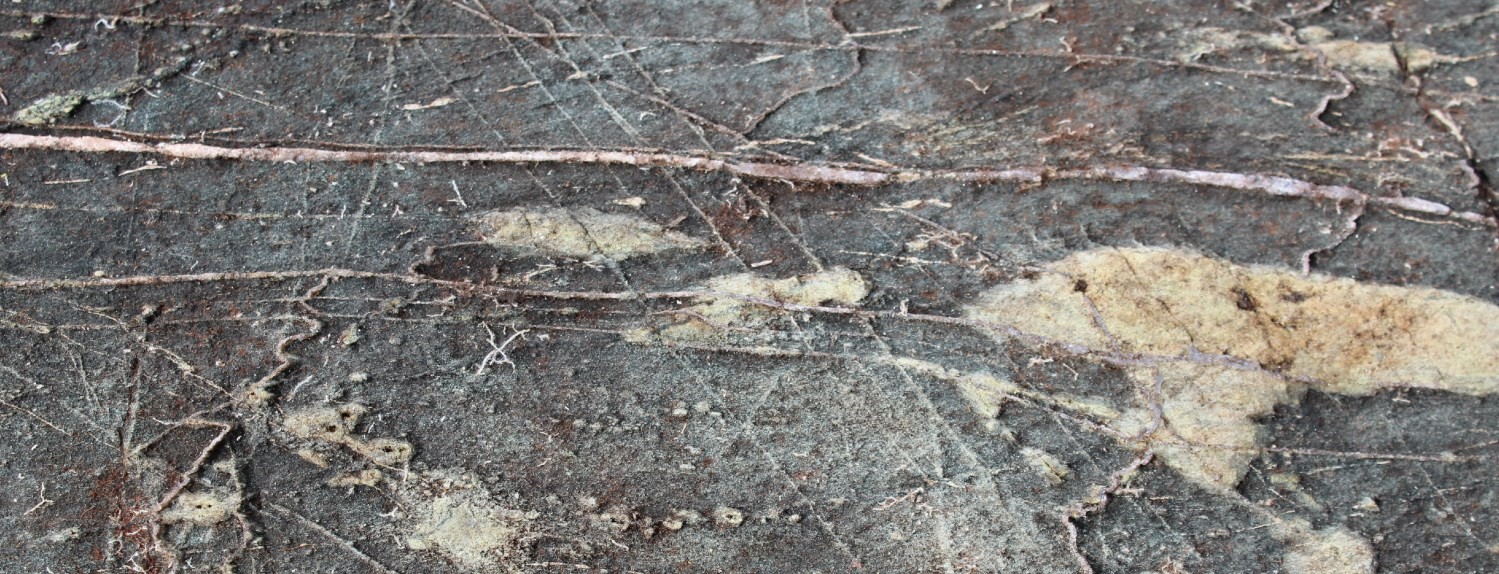
Last modified: 4 December 2020
DISCLAIMER: This English version is translated from the original French. In case of any discrepancy, the French version shall prevail.
| Author: | Beauchamp et al., 2018 |
| Age: | Neoarchean |
| Stratotype: | None |
| Type area: | Bohier Island area |
| Geological province: | Superior Province |
| Geological subdivision: | Opatica Subprovince |
| Lithology: | Mafic and ultramafic volcanic and intrusive rocks, chert, iron formation and felsic tuff |
| Category: | Lithostratigraphic |
| Rank: | Formation |
| Status: | Formal |
| Use: | Active |
Background
Volcanic and volcaniclastic rocks of the Upper Eastmain Greenstone Belt (UEGB) were described in the works of Hocq (1985), Roy (1985, 1988), Couture (1986, 1987a, 1987b, 1987c, 1993) and Couture and Guha (1990). At that time, these authors grouped all the rocks within the René Group, without individualizing any formation. Following geological mapping in the Bohier Island area during the summer of 2017, Beauchamp et al. (2018) divided the René Group into four formations. The Dolent Formation, located south of the lake of the same name, was introduced to define volcanic rocks of the western and northern branches of the UEGB.
At the time of the Bohier Island geological map (Beauchamp et al., 2018), the Dolent Formation (nAdln) was divided into five (5) informal units: 1) predominantly basaltic (nAdln1) and porphyritic to glomeroporphyric basalt (nAdln1a), 2) gabbro (nAdln2), 3) ultramafic intrusive rock (nAdln3), 4) ultramafic volcanic unit (nAdln4), and 5) sulphidic chert and iron formation (nAdln5).
The following year, Beauchamp (2020) updated the Dolent Formation stratigraphy to refine the nomenclature of some informal subdivisions. Amphibolite has been added to unit nAdln2. Unit nAdln3 now consists of mafic-ultramafic sills; in addition, ultramafic sills have been added to komatiites of unit nAdln4. Finally, felsic tuff unit (nAdln6) was also individualized following work in the Cadieux Lake area (Beauchamp, 2020).
Description
The Dolent Formation includes volcanics from the west and north branches of the UEGB. Stratigraphic piling within the formation begins with the emplacement of mafic-ultramafic sills (nAdln3) and chert, iron formation (nAdln5) and felsic tuff (nAfln6). The main unit of the formation, consisting of pillow to massive basalts (nAdln1), locally porphyritic (nAdln1a), is overlying. Finally, ultramafic sills and flows (nAdln4) appear to be at the top of the pile. The stratigraphic position of amphibolite and gabbro (nAdln2) at the western end of the western branch of the UEGB was not determined.
Dolent Formation 1 (nAdln1): Amphibolitized Pillow and Massive Flow Basalt, Minor Amounts of Felsic Tuff and Gabbro
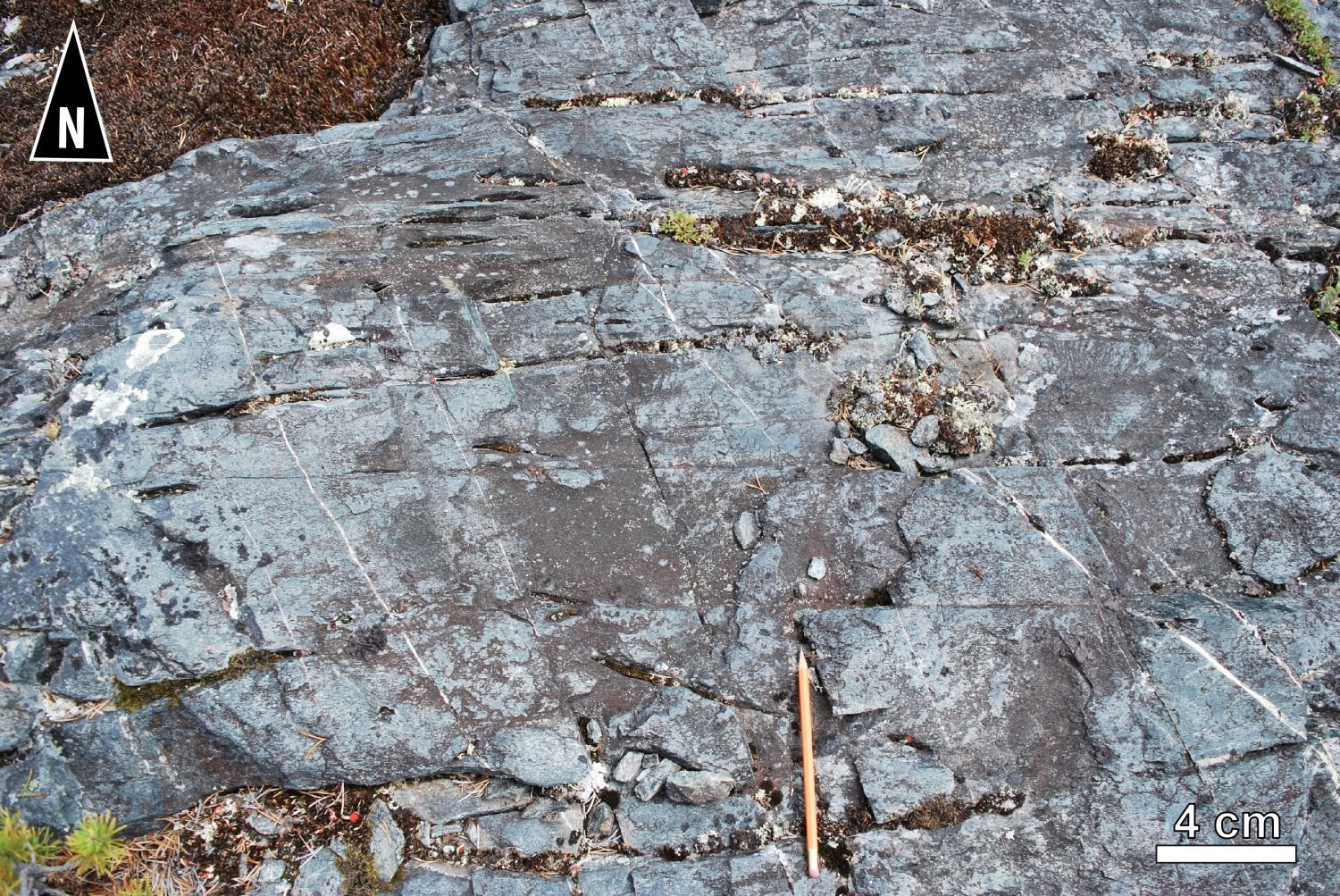


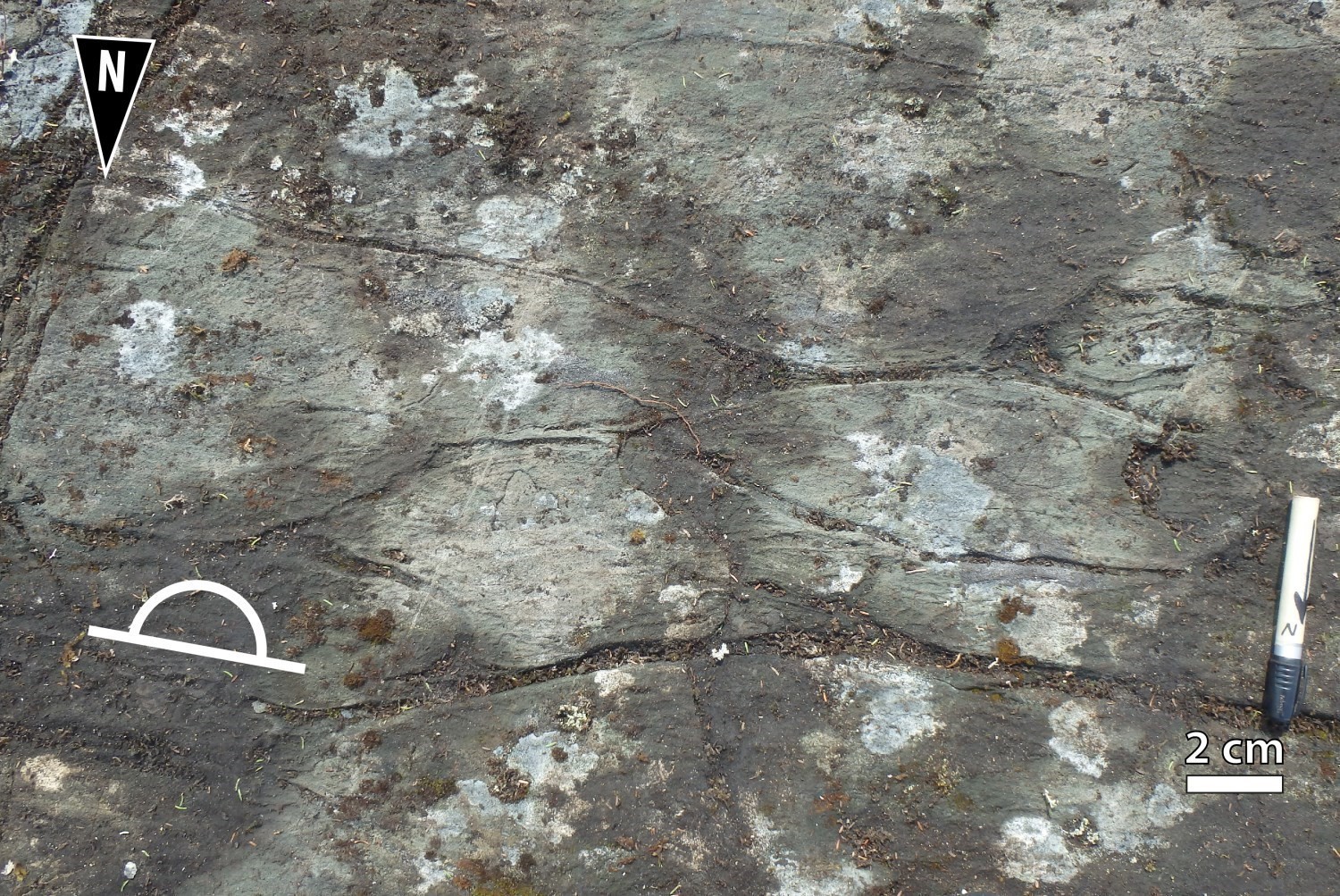 Unit nAdln1 usually consists of very fine or fine-grained pillow basalts and massive flow basalts. Minor proportions of felsic tuff and gabbro, not visible at the scale of the Ministère’s geological maps, are present in the pile of mafic extrusive rocks. The pillow facies dominates the west and north branch of the UEGB and south of Dolent Lake. The massive facies is most prevalent in the Bohier Island area and north of the east branch of the belt. Some outcrops exhibit weakly-deformed pillows, while others are flattened. Locally observed were peduncles, molar tooth-shaped pillows, quartz chambers, saussuritized pillow cores, micro-pillow (<10 cm), mega-pillow (>1.5 m wide) areas and brecciated flows. Pillow edges are blackish and well defined. The latter contain biotite, chlorite, amphiboles and sulphides. Basalt is generally non-magnetic.
Unit nAdln1 usually consists of very fine or fine-grained pillow basalts and massive flow basalts. Minor proportions of felsic tuff and gabbro, not visible at the scale of the Ministère’s geological maps, are present in the pile of mafic extrusive rocks. The pillow facies dominates the west and north branch of the UEGB and south of Dolent Lake. The massive facies is most prevalent in the Bohier Island area and north of the east branch of the belt. Some outcrops exhibit weakly-deformed pillows, while others are flattened. Locally observed were peduncles, molar tooth-shaped pillows, quartz chambers, saussuritized pillow cores, micro-pillow (<10 cm), mega-pillow (>1.5 m wide) areas and brecciated flows. Pillow edges are blackish and well defined. The latter contain biotite, chlorite, amphiboles and sulphides. Basalt is generally non-magnetic.
In thin section, unit nAdln1 basalt contains 50 to 70% hornblende (locally twinned actinolite), plagioclase, epidote and sericite. Subhedral to euhedral hornblende crystals are stocky, locally poikiloblastic, and are aligned with the main fabric. A nematoblastic to nematolepidoblastic texture results from the arrangement of minerals. In some cases, metamorphism has significantly increased basalt grain size. The medium-grained rock contains amphiboles up to 1 cm in size. Fine sericite flakes and cryptocrystalline epidote clusters alter plagioclase grains, in places only identifiable by the mineral shape. Circular cavities filled with an epidote-quartz-calcite ± sericite ± chlorite assemblage correspond to amygdules. The following trace minerals were observed in thin section: chlorite, calcite, quartz, biotite, garnet, sphene, clinopyroxene, rutile, zircon, iron oxides, sulphides and opaque minerals. Several veins and veinlets composed of quartz, feldspar, calcite, chlorite and epidote cut basalts in several directions.
From a geochemical perspective (Beauchamp, 2020), mafic extrusive rocks of the Dolent Formation fall in the fields of subalkaline basalt and andesitic basalt in the Winchester and Floyd (1977) diagram. Some samples consist of magnesian basalt (MgO >9%). These rocks are of tholeiitic affinity (Ross and Bédard, 2009) and are characterized by relatively flat profiles on rare earth and spider diagrams. Small negative anomalies in Nb-Ta and P appear on the spider diagram. Unit nAdln1, which resembles N-MORB with low crustal contamination, would have been emplaced in an island arc, probably in the back-arc position.
Dolent Formation 1a (nAdln1a): Porphyritic or Glomerophyric Basalt

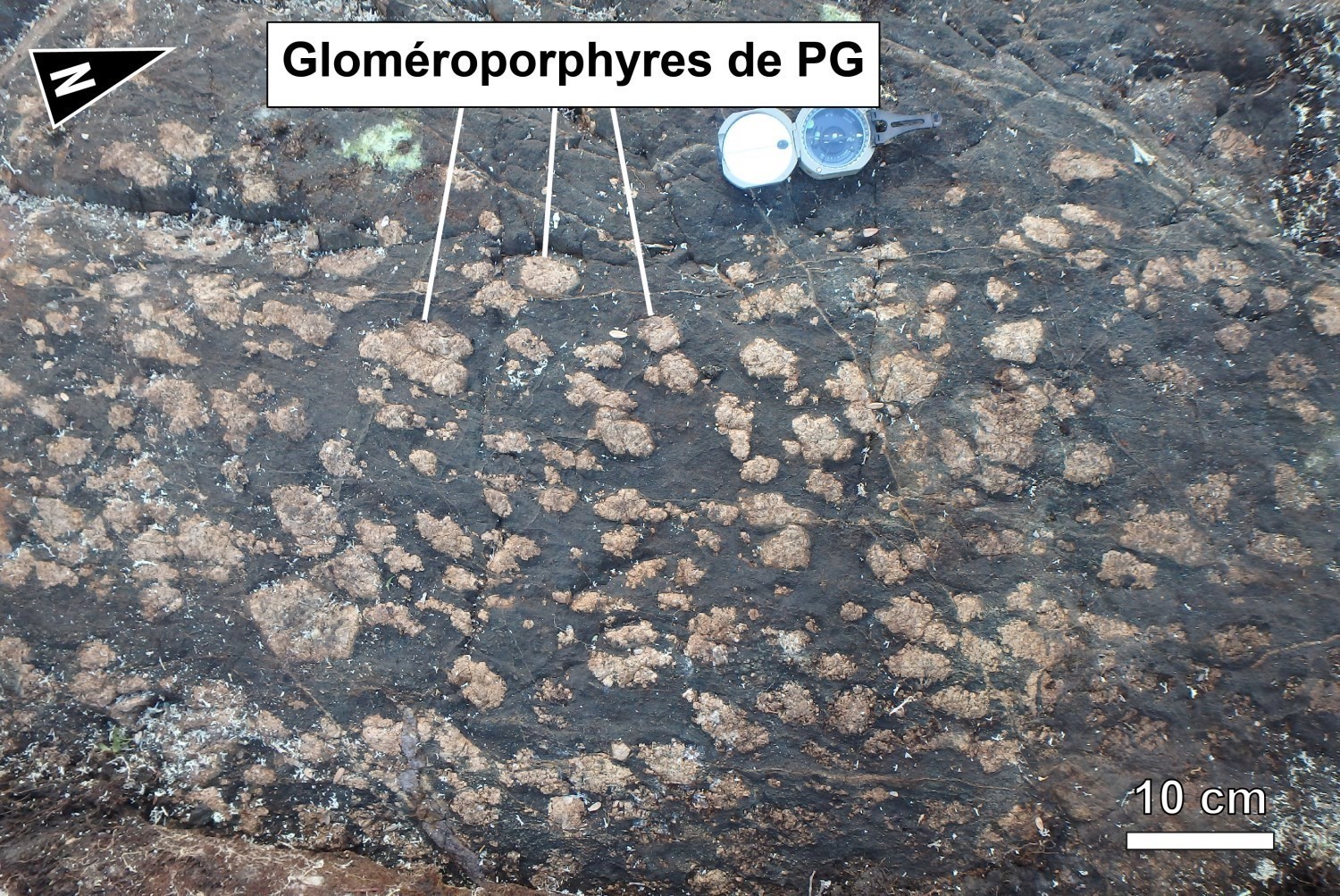 Subunit nAdln1a represents the porphyritic and glomerophyric basalt facies. As a marker of volcanic stratigraphy, this unit was isolated on the geological map of Beauchamp et al. (2018). Generally pillowed, subunit nAdln1a contains 2 to 15% plagioclase phenocrystals (0.5-1 cm). Glomerophyric textures are also present. Phenocrystal clusters (1-5 cm) are rounded to subrounded. Because these clusters are denser than individual crystals, they tend to accumulate in the lower portion of magmatic bodies, which allows for locating their base.
Subunit nAdln1a represents the porphyritic and glomerophyric basalt facies. As a marker of volcanic stratigraphy, this unit was isolated on the geological map of Beauchamp et al. (2018). Generally pillowed, subunit nAdln1a contains 2 to 15% plagioclase phenocrystals (0.5-1 cm). Glomerophyric textures are also present. Phenocrystal clusters (1-5 cm) are rounded to subrounded. Because these clusters are denser than individual crystals, they tend to accumulate in the lower portion of magmatic bodies, which allows for locating their base.
Dolent Formation 2 (nAdln2): Amphibolite and Gabbro
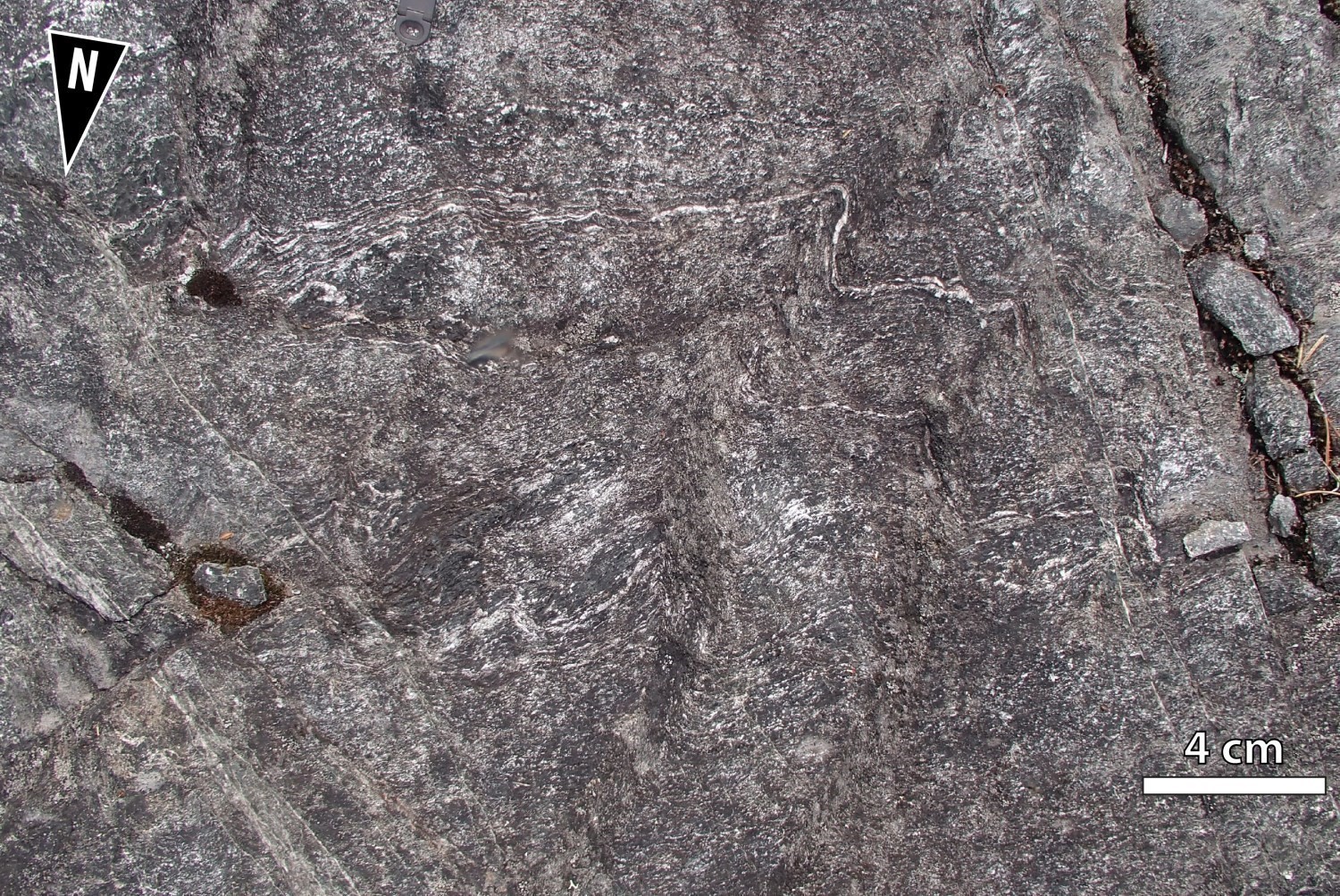
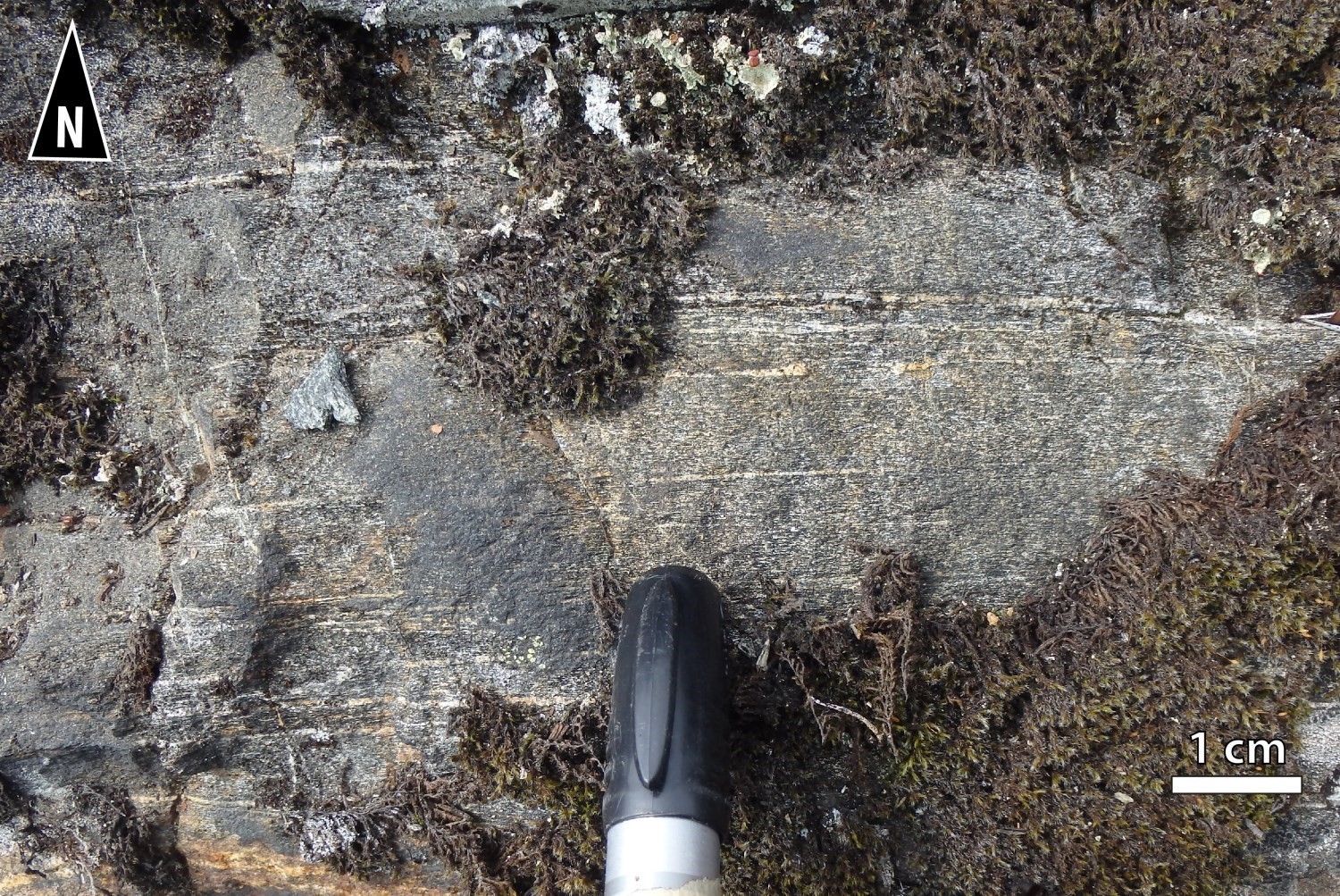
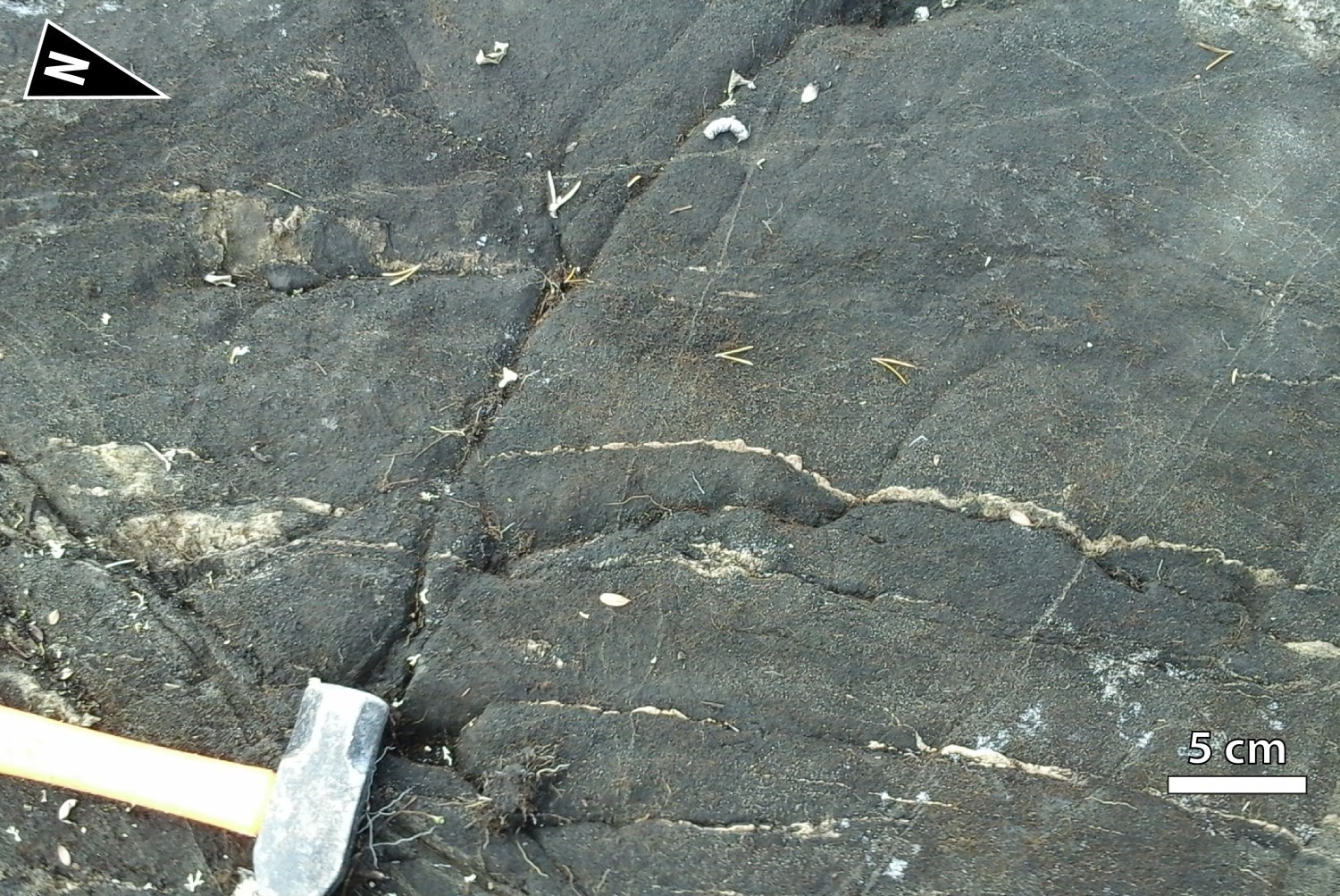 Unit nAdln2 was reassigned to amphibolitized mafic rocks at the western end of the west branch of the UEGB (Beauchamp, 2020). It consists of foliated and lineated medium-grained amphibolite and amphibolitized gabbro. The rock is blackish green in altered patina and dark green in fresh exposure. Byron and Clark (1999) suggest a volcanic origin for amphibolites of this unit.
Unit nAdln2 was reassigned to amphibolitized mafic rocks at the western end of the west branch of the UEGB (Beauchamp, 2020). It consists of foliated and lineated medium-grained amphibolite and amphibolitized gabbro. The rock is blackish green in altered patina and dark green in fresh exposure. Byron and Clark (1999) suggest a volcanic origin for amphibolites of this unit.
Rocks observed in thin section show a relatively simple composition. The matrix is polygonal, granoblastic and composed of euhedral hornblende and plagioclase altered by clusters of epidote and fine sericite. Clinopyroxene and sphene are common (≤5%). Traces of biotite, chlorite, muscovite and magnetite were observed. Unit nAdln2 is strongly affected by regional deformation (Dn) and by a crenulation associated with Dn+1. The main fabric is defined by the alignment of amphibole grains. Millimetric plagioclase-rich white bands appear to be leucosome (1-2%). Amphiboles that can reach 1 cm form clusters randomly oriented around the mobilisate. Sericite-chlorite schist and metasomatic alteration zones composed of cummingtonite-grunerite, epidote, phlogopite, talc, garnet, pyrrhotite and pyrite have been identified in unit nAdln2.
From a geochemical perspective (Beauchamp, 2020), unit nAdln2 mafic rocks consist of subalkaline basalt and andesitic basalt of tholeiitic affinity characterized by relatively flat profiles on rare earth and spider diagrams. Rocks are rich in magnesium with MgO contents ranging from 8.11% to 11.18%. Weak negative anomalies in Nb, Ta and P appear on the spider diagram.
Dolent Formation 3 (nAdln3): Mafic-Ultramafic Sill
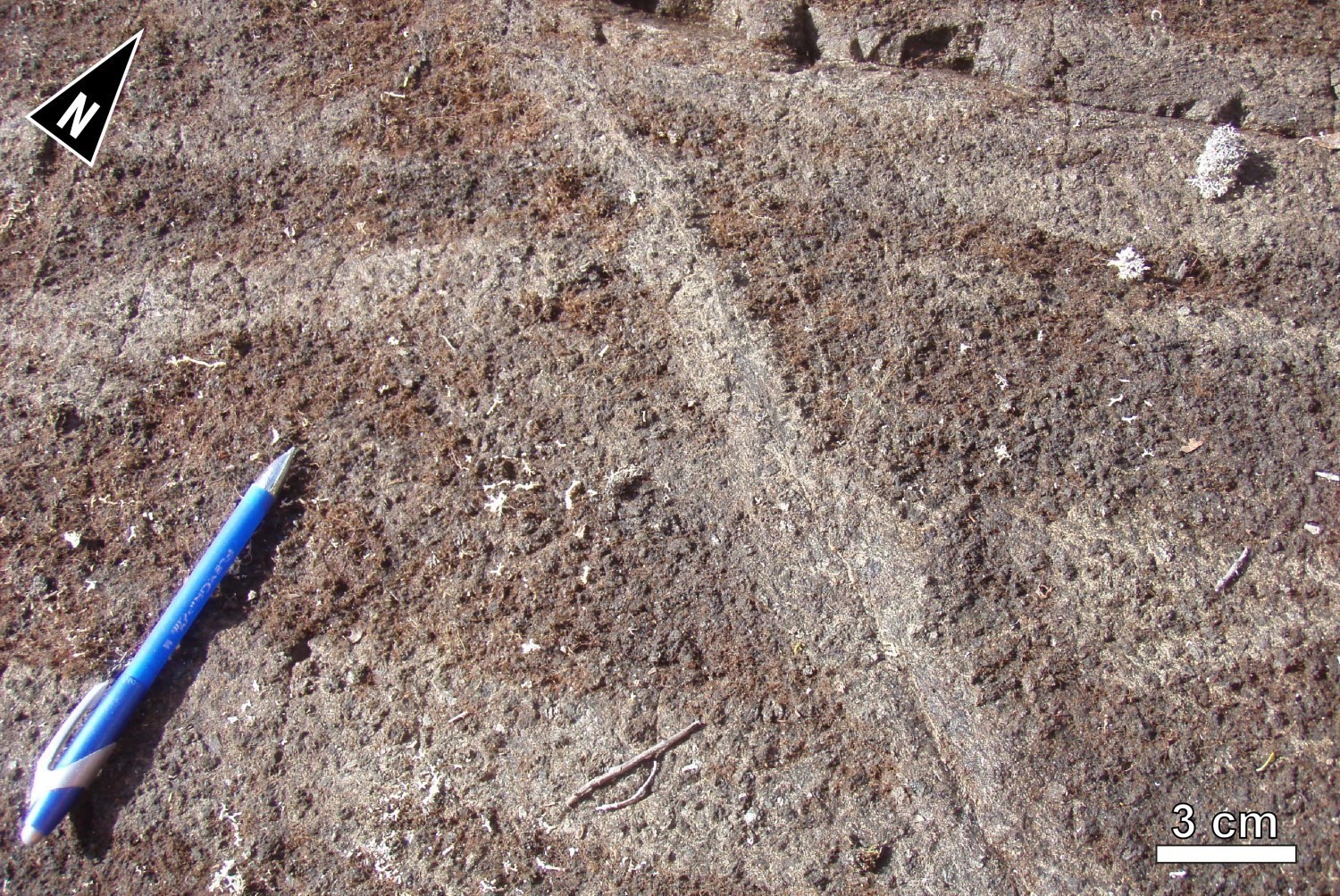
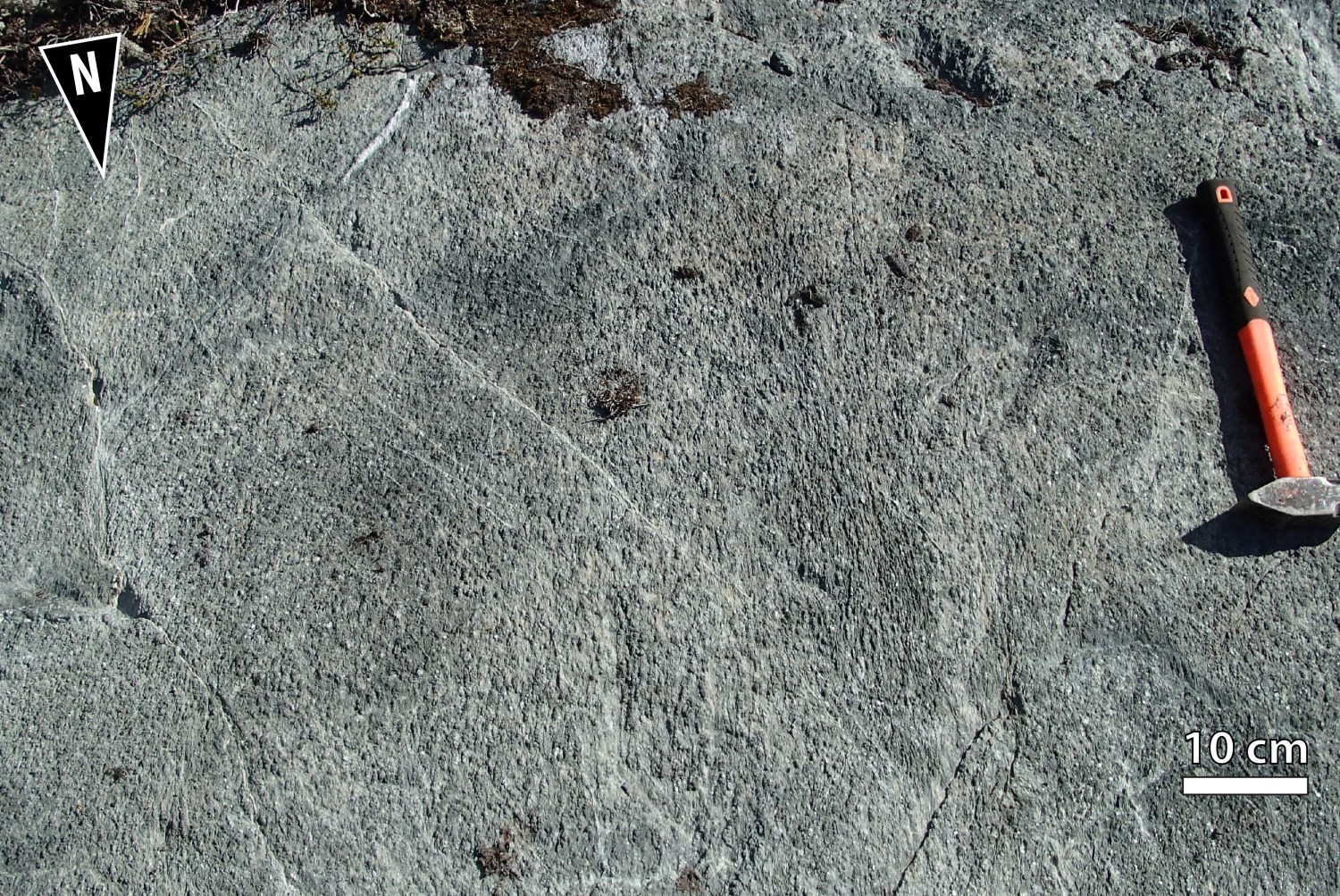 This unit consists mostly of pyroxenite and melanocratic amphibolitized gabbro. A few peridotite outcrops are present. The largest sill, 30 km long by 100 m to 200 m thick, is located north of the western branch of the UEGB. Medium to coarse-grained, unit nAdln3 is particularly melanocratic and black-grey to dark greenish grey. The rock is composed of amphibole measuring a few millimetres and plagioclase in smaller equigranular crystals. It is homogeneous, non magnetic and massive to weakly foliated. Small local shear zones of centimetric to decametric amplitude accentuate deformation in some areas of the rock. Also observed is a pronounced alteration characterized by a high presence of epidote (zoisite/clinozoisite) and sericite replacing plagioclase grains. Amphiboles belong mainly to the actinolite-tremolite series. In the heart of the western branch, gabbro is less altered, sericitization is very low and the most abundant amphibole is hornblende. Traces of sphene, magnetite and opaque minerals have been observed.
This unit consists mostly of pyroxenite and melanocratic amphibolitized gabbro. A few peridotite outcrops are present. The largest sill, 30 km long by 100 m to 200 m thick, is located north of the western branch of the UEGB. Medium to coarse-grained, unit nAdln3 is particularly melanocratic and black-grey to dark greenish grey. The rock is composed of amphibole measuring a few millimetres and plagioclase in smaller equigranular crystals. It is homogeneous, non magnetic and massive to weakly foliated. Small local shear zones of centimetric to decametric amplitude accentuate deformation in some areas of the rock. Also observed is a pronounced alteration characterized by a high presence of epidote (zoisite/clinozoisite) and sericite replacing plagioclase grains. Amphiboles belong mainly to the actinolite-tremolite series. In the heart of the western branch, gabbro is less altered, sericitization is very low and the most abundant amphibole is hornblende. Traces of sphene, magnetite and opaque minerals have been observed.
Ultramafic sills were recorded in the UEGB north branch (outcrops 17-MQ-8015 and 17-JF-5209) and east branch (outcrop 17-AB-1043). Drilling series 90-EM-05 to 90-EM-12 conducted by Kingswood Explorations 1985 Ltd. in 1990 (Beesley and Goulet, 1992) confirms the extension of the ultramafic band of the eastern branch. Unit nAdln3 includes two peridotitic facies which show or not cumulate textures. Ultramafic rocks displaying cumulate textures are dark grey to orange brown. The rock is fine to medium grained and very magnetic. Between 40 and 50% of altered orange minerals (Beesley and Goulet, 1992), possibly orthopyroxene or olivine, are observed. The matrix consists of tremolite and antigorite. Foliation is mainly marked by serpentine flakes. When the cumulate texture is not present, the rock shows a marked penetrative foliation overprinted by a crenulation schistosity. It is also amphibolitized, biotitized and contains talc, tremolite (locally as radial fibrous acicular crystals) and magnetite. In thin section, the rock shows serpentine and small post-kinematic hornblende crystals.
Based on geochemical data (Beauchamp, 2020), the normative composition of unit nAdln3 samples in sheet 33A07 consists predominantly of pyroxenite (olivine websterite) and magnesium-rich olivine gabbro (>8.5% MgO), and a minor amount of lherzolitic peridotite. These rocks are of tholeiitic affinity and show flat rare earth profiles.
Dolent Formation 4 (nAdln4): Ultramafic Sill and Volcanics (Komatiite)
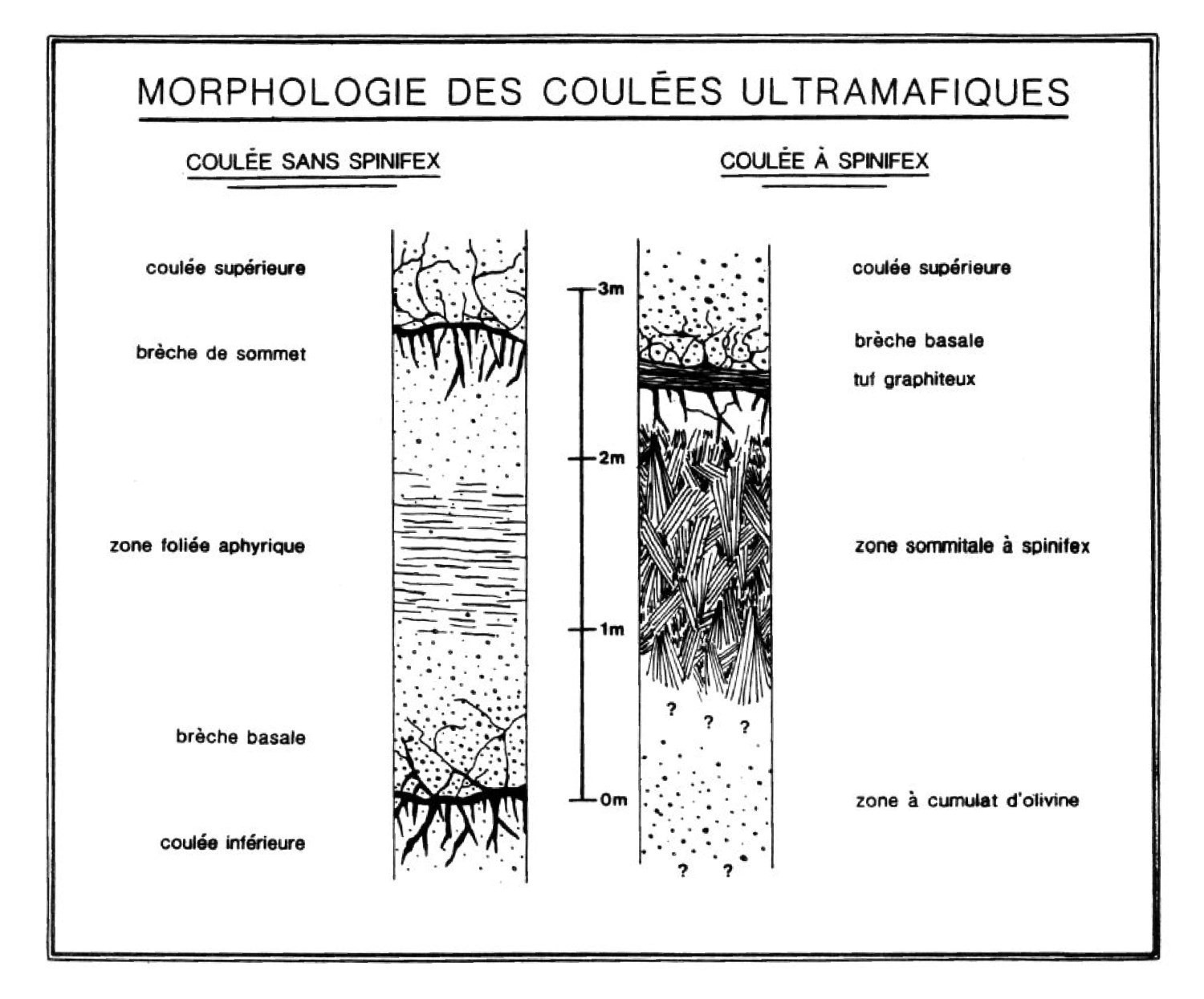
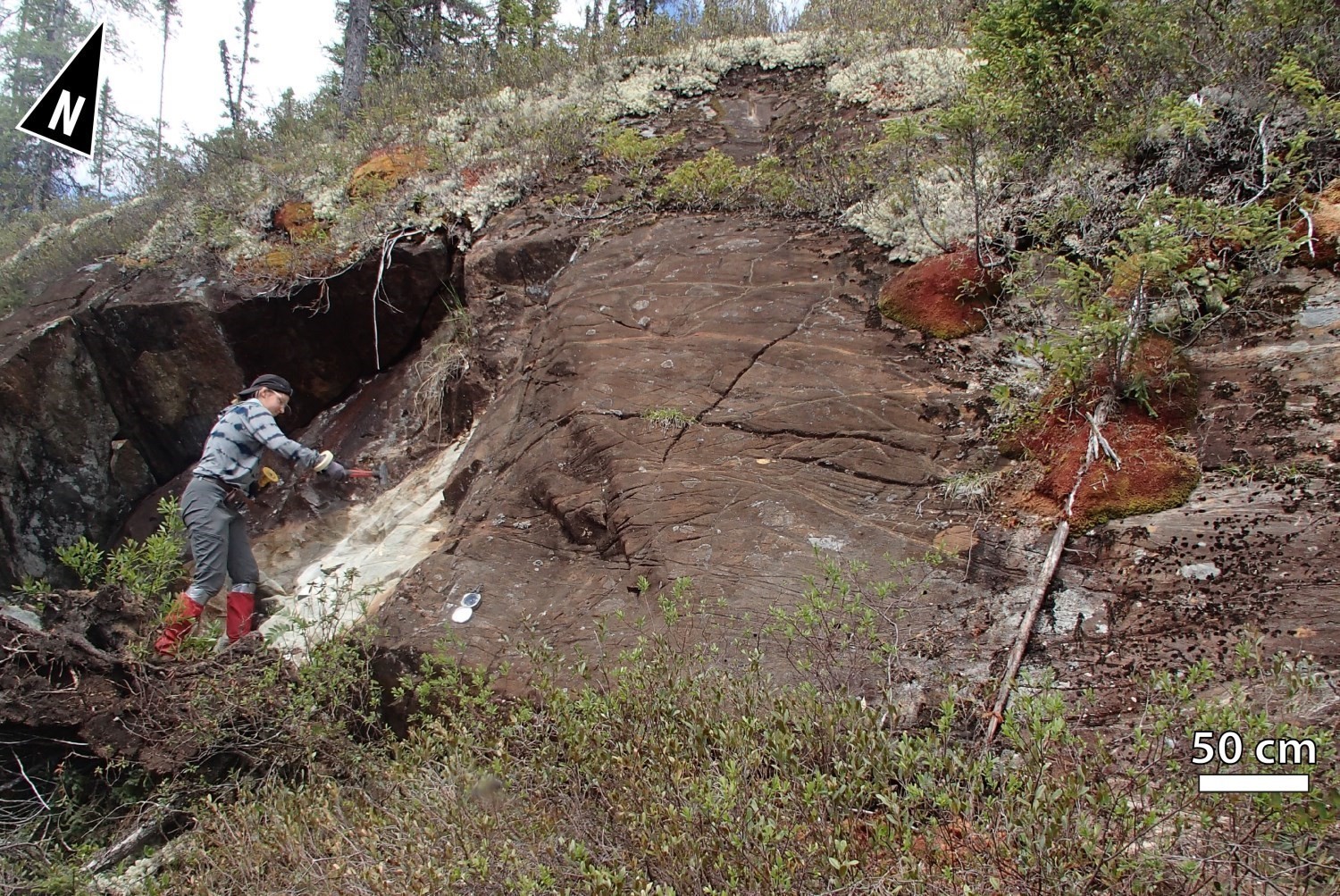
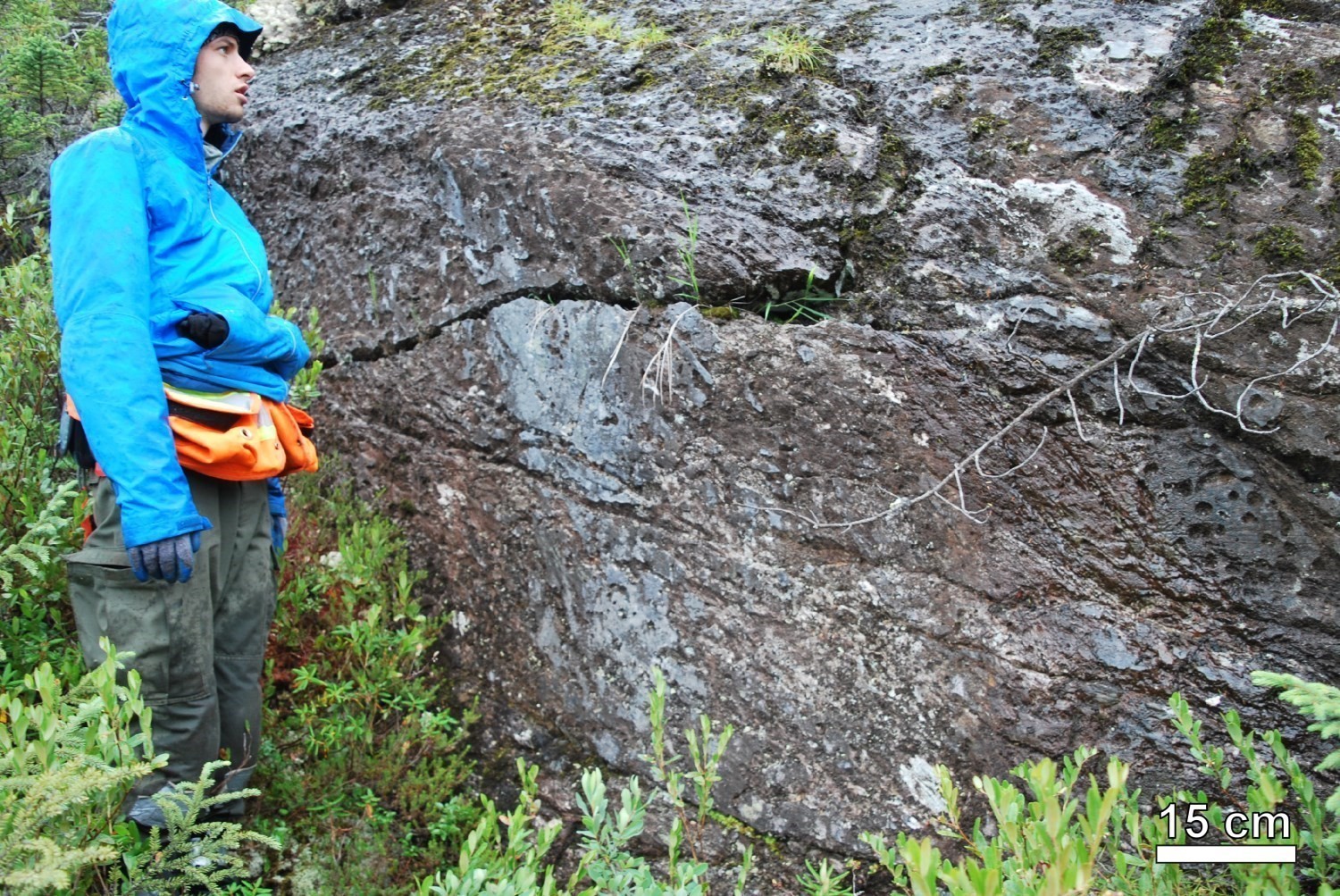 Unit nAdln4 consists of an assemblage of ultramafic sills and volcanics. It was mapped immediately north of Lépante Lake (Couture 1987; Beauchamp, 2020) and 2 km south of Dolent Lake (Beauchamp et al., 2018). The ultramafic unit is relatively thin, 200 m to 300 m thick (Couture, 1987) and was traced laterally continuously over ~25 km. In altered patina, ultramafic rocks change from brown to light green. In fresh exposure, they are blackish to dark green. A cracked texture resembling snake skin and a friable patina characterize the unit.
Unit nAdln4 consists of an assemblage of ultramafic sills and volcanics. It was mapped immediately north of Lépante Lake (Couture 1987; Beauchamp, 2020) and 2 km south of Dolent Lake (Beauchamp et al., 2018). The ultramafic unit is relatively thin, 200 m to 300 m thick (Couture, 1987) and was traced laterally continuously over ~25 km. In altered patina, ultramafic rocks change from brown to light green. In fresh exposure, they are blackish to dark green. A cracked texture resembling snake skin and a friable patina characterize the unit.
Two types of flows were recognized by Couture (1987): typical spinifex flows, and flows without a spinifex sommital zone. Typical flows consist of an olivine cumulate basal zone and a spinifex sommital zone. The shape of spinifex needles suggests that their primary mineral was pyroxene rather than olivine. In thin section, the primary texture of the cumulate zone is relatively well preserved, despite complete metamorphic recrystallization. Olivine pseudomorphs are composed of serpentine and magnetite. According to Dejou (1987), only a few ultramafic samples show spinifex textures. During field work in the Bohier Island and Cadieux Lake areas, no spinifex flow was identified by Beauchamp et al. (2018) and Beauchamp (2020).
Spinifex-free flows outcrop on a hill ~2.5 km SW of Lépante Lake and south of Dolent Lake. Flows are lenticular and are 5 m to 10 m thick. Piling of flows appears to have been rapid since no interflow sediments are present (Couture, 1987). Spinifex-free flows generally consist of three distinct parts: an olivine porphyritic basal part, an aphyritic median part and a small olivine porphyritic sommital part. In situ basal and sommital breccias are well developed and allow for the identification of the top of the layers (Couture, 1987). In some places, cooling fractures can be interpreted (Beauchamp, 2020). Sheet flows form elongated lobes that peak sharply. The scarcity of primary volcanic textures observed by Beauchamp (2020) suggests that several flows interpreted by Couture (1987) would be sills whose magmatic layering would have been preserved. Some differentiated peridotitic sills change laterally to pyroxenite and melanocratic gabbro.

 In thin section, unit nAdln4 rocks are very serpentinized. The matrix is fine to very fine grained, mostly composed of intergrown recrystallized needles occurring as a mosaic of monoclinic acicular amphiboles of the tremolite-actinolite series (Couture, 1987; Beauchamp, 2020). In some thin sections, the long axis of colourless amphiboles is oriented along the main fabric (syntectonic), while in others, grains are randomly oriented, cutting foliation (post-tectonic). Serpentine is abundant (20-60%), pervasive and is present both in the matrix and replacing olivine cumulates. A mesh texture materializes serpentinization of olivine; In addition, fibrous serpentine in bastite texture completely replaces orthopyroxene grains. There are still some sparse olive remains. A talc-magnetite-Mg chlorite assemblage is ubiquitous. Talc alters olivine grains and tremolite, forming sub-rounded clusters in the matrix. Magnetitte is associated with serpentine and occurs as aligned grains replacing olivine. Phlogopite, magnesite, epidote, carbonates and white micas are accessory minerals (trace-5%). The surface of ultramafic rocks is lined with sinuous and discontinuous serpentine and talc veinlets. Some serpentine veins have crack and seal textures.
In thin section, unit nAdln4 rocks are very serpentinized. The matrix is fine to very fine grained, mostly composed of intergrown recrystallized needles occurring as a mosaic of monoclinic acicular amphiboles of the tremolite-actinolite series (Couture, 1987; Beauchamp, 2020). In some thin sections, the long axis of colourless amphiboles is oriented along the main fabric (syntectonic), while in others, grains are randomly oriented, cutting foliation (post-tectonic). Serpentine is abundant (20-60%), pervasive and is present both in the matrix and replacing olivine cumulates. A mesh texture materializes serpentinization of olivine; In addition, fibrous serpentine in bastite texture completely replaces orthopyroxene grains. There are still some sparse olive remains. A talc-magnetite-Mg chlorite assemblage is ubiquitous. Talc alters olivine grains and tremolite, forming sub-rounded clusters in the matrix. Magnetitte is associated with serpentine and occurs as aligned grains replacing olivine. Phlogopite, magnesite, epidote, carbonates and white micas are accessory minerals (trace-5%). The surface of ultramafic rocks is lined with sinuous and discontinuous serpentine and talc veinlets. Some serpentine veins have crack and seal textures.
According to geochemical data (Beauchamp, 2020), the normative composition of ultramafic sills and volcanics is mostly harzburgite and more locally olivine websterite, of tholeiitic affinity, showing flat rare earth profiles. A slight negative Eu anomaly is observed. One of the distinguishing features of harzburgite is its very high magnesium content (72.69-85.66% MgO). On the spider diagram, this unit has negative anomalies in Nb, Ta, Eu and P as well as positive anomalies in La and Ce. Unit nAdln4 is a highly hydrated altered rock with significant loss on ignition values (10.43-12.11%).
Dolent Formation 5 (nAdln5): Sulphidic Chert and Iron Formation
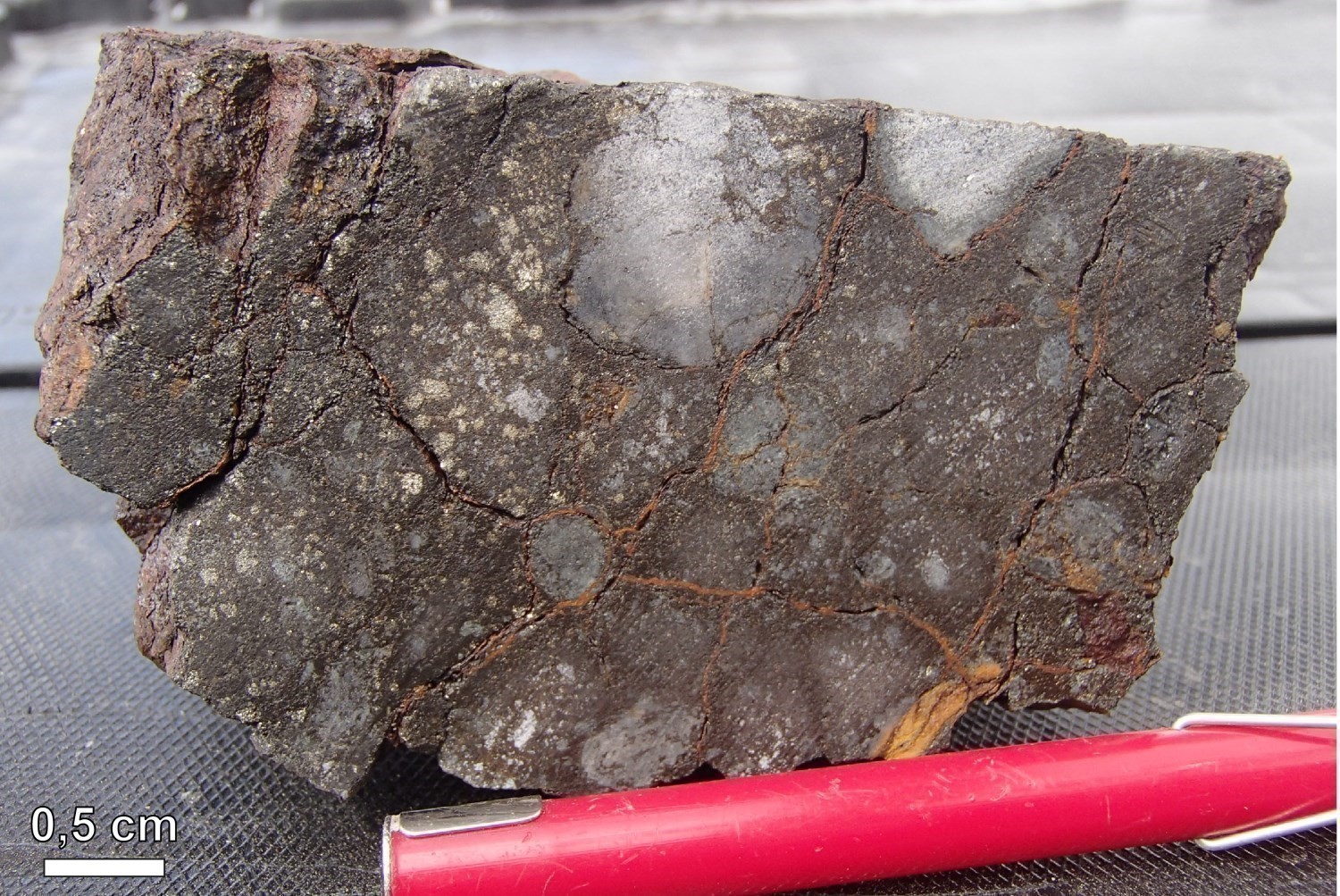 A number of sulphidic chert and iron formation bands were observed in the northern half of the west branch of the UEGB. Chert bands are recrystallized, laminated and interstratified with massive sulphide layers. Outcrops have a rusty alteration crust. Sulphides are mainly pyrrhotite, pyrite and, in lesser amounts, chalcopyrite. Chalcopyrite is mainly present in the walls of quartz veins cutting the unit. The main minerals are quartz and sulphides. Accessory minerals are amphibole, epidote, muscovite and, more sparsely, plagioclase and carbonates.
A number of sulphidic chert and iron formation bands were observed in the northern half of the west branch of the UEGB. Chert bands are recrystallized, laminated and interstratified with massive sulphide layers. Outcrops have a rusty alteration crust. Sulphides are mainly pyrrhotite, pyrite and, in lesser amounts, chalcopyrite. Chalcopyrite is mainly present in the walls of quartz veins cutting the unit. The main minerals are quartz and sulphides. Accessory minerals are amphibole, epidote, muscovite and, more sparsely, plagioclase and carbonates.
Dolent Formation 6 (nAdln6): Felsic Tuff
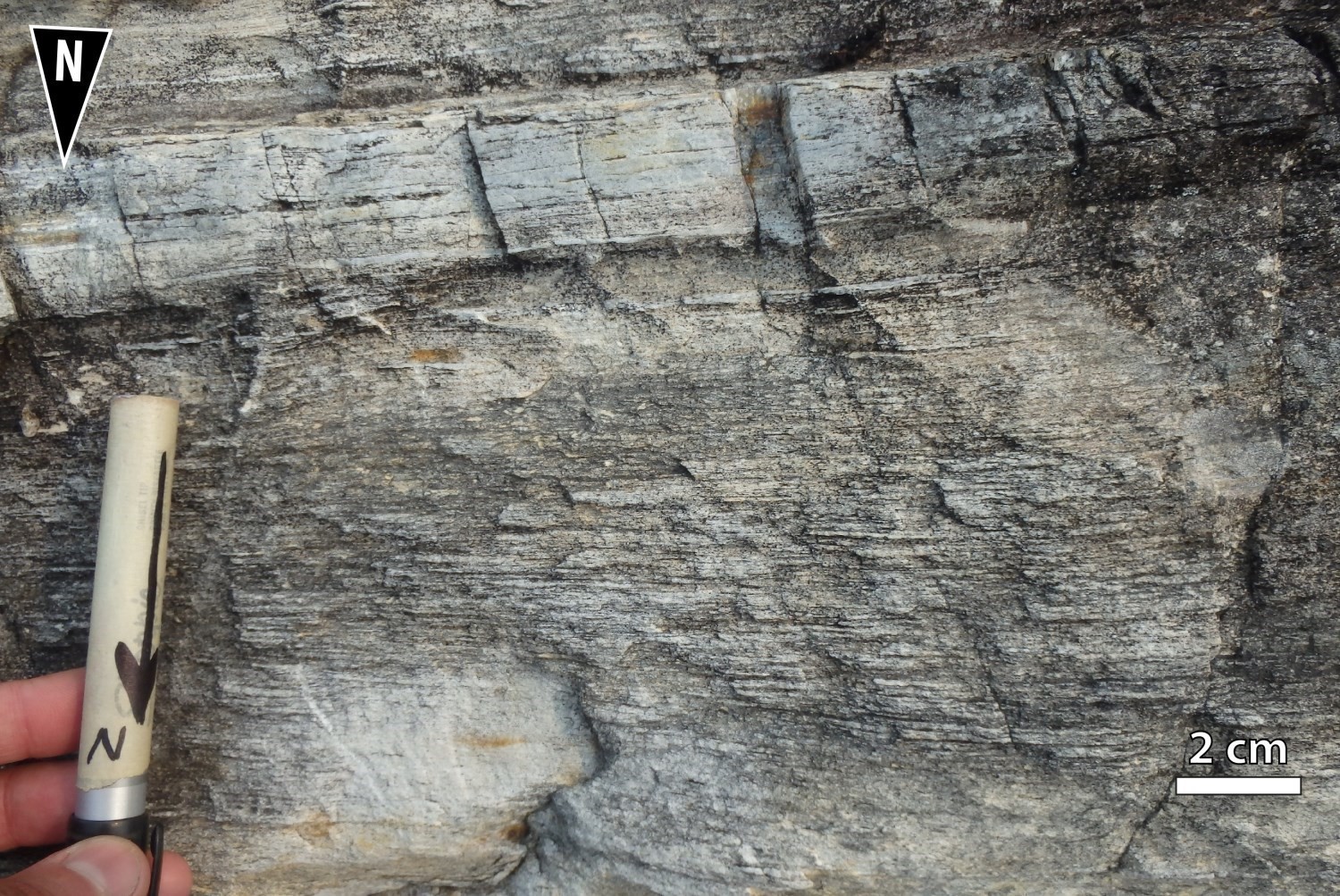
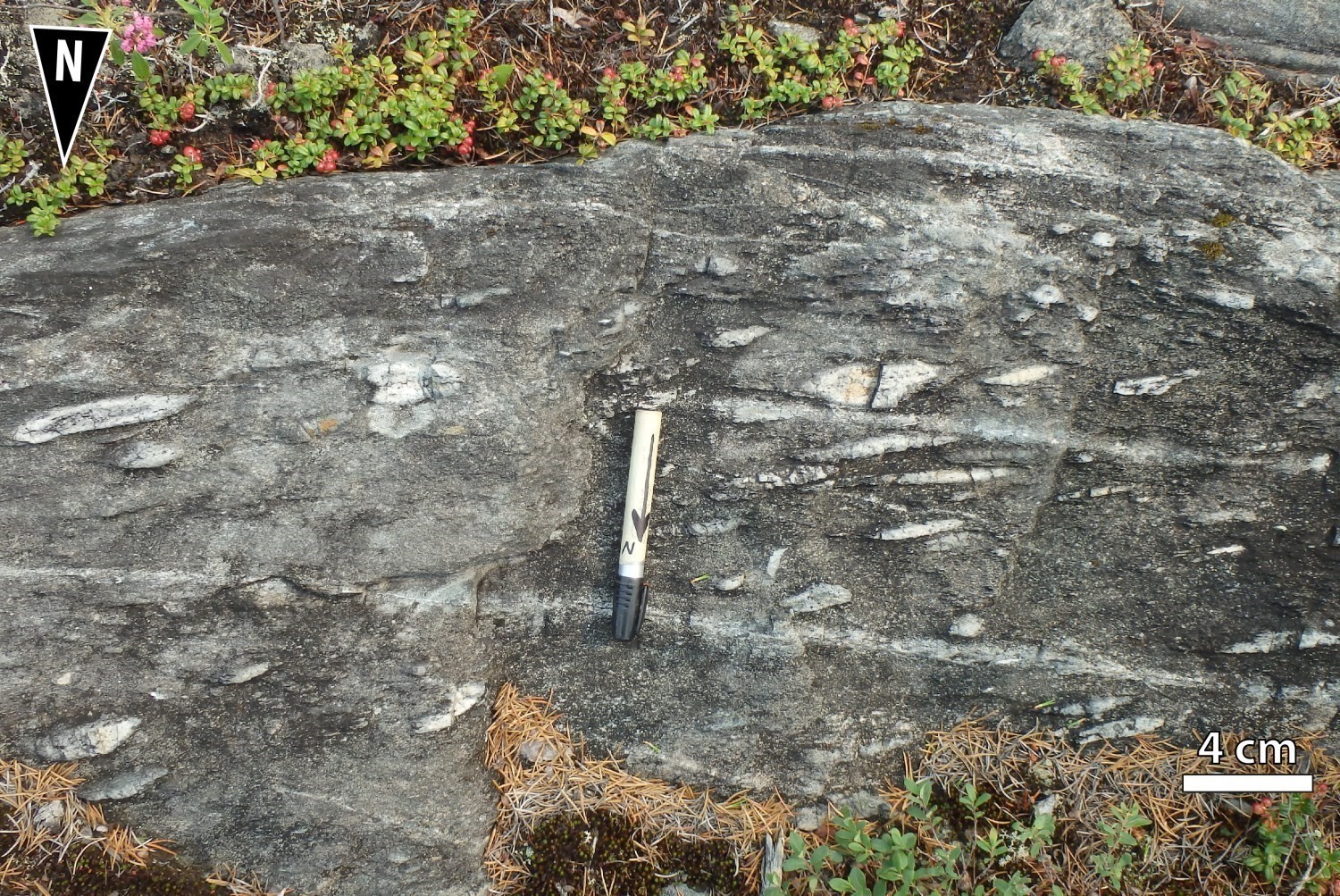 Thin layers of felsic tuff were found at the eastern end of the west branch of the UEGB. These are in contact with a mafic-ultramafic sill of unit nAdln3. In this area, rocks have been described as tuff showing millimetre-to-centimetre-thick laminations. The compositional layering is marked by a variation in the grain size and colour of the rock. A felsic lapilli metric layer is present. In thin section, tuff contains quartz with undulatory extinction and plagioclase. Hydrothermal alteration forms cryptocrystalline epidote-fine sericite-chlorite ± garnet ± calcite discontinuous bands. Meter-thick rusty layers are present and characterized by disseminated sulphides (pyrite-pyrrhotite, ≤5%), quartz and sulphide (pyrrhotite-pyrite) veinlets and veins, and stratiform sulphide clusters (disseminated to semi-massive) (outcrop 18-PG-4088).
Thin layers of felsic tuff were found at the eastern end of the west branch of the UEGB. These are in contact with a mafic-ultramafic sill of unit nAdln3. In this area, rocks have been described as tuff showing millimetre-to-centimetre-thick laminations. The compositional layering is marked by a variation in the grain size and colour of the rock. A felsic lapilli metric layer is present. In thin section, tuff contains quartz with undulatory extinction and plagioclase. Hydrothermal alteration forms cryptocrystalline epidote-fine sericite-chlorite ± garnet ± calcite discontinuous bands. Meter-thick rusty layers are present and characterized by disseminated sulphides (pyrite-pyrrhotite, ≤5%), quartz and sulphide (pyrrhotite-pyrite) veinlets and veins, and stratiform sulphide clusters (disseminated to semi-massive) (outcrop 18-PG-4088).
Geochemical analyses (Beauchamp, 2020) show that felsic tuff has a rhyodacitic composition and a calc-alkaline affinity. There is an Eu anomaly and a high enrichment in light rare earths (10.57 < [La/Yb]N < 13.78). On the spider diagram normalized to the primitive mantle, rocks are characterized by pronounced negative anomalies in Nb, Ta, P, sm and Ti, as well as positive anomalies in Th, La and Ce.
Thickness and Distribution
The Dolent Formation is located in the west and north branches, as well as the north part of the east branch of the UEGB. The thickness ranges from 0.8 km to 1.2 km.
Dating
A laminated rhyodacitic tuff sample (18-PG-4090-A) at the NW end of the Dolent Formation has been dated (U-Pb on zircon). The age of volcanism has been estimated at 2751 ±5 Ma (Davis, 2019).
Stratigraphic Relationship(s)
The Dolent Formation is part of the René Group. It corresponds to the youngest volcanic event in the UEGB. However, its stratigraphic position with respect to the Clément Formation (<2770 Ma, relative age, not dated), described only in the southern branch of the UEGB, is not known. Bohier Group sedimentary rocks (<2712 ±6 Ma; Davis and Sutcliffe, 2018b) are younger than Dolent Formation volcanic rocks. In the west branch of the UEGB, Bohier Group conglomerates (nAbh2) overlie in fault contact Dolent Formation basalts.
Supracrustal rocks overlie Mesoarchean to Neoarchean gneissic and intrusive rocks belonging to the Misasque Complex and Digne Pluton. They are also cut by granodiorite and quartz monzodiorite belonging to the Macleod Batholith and Cadieux Suite.
Paleontology
Does not apply.
References
Publications available through SIGÉOM Examine
BEAUCHAMP, A M. 2020. Géologie de la région du lac Cadieux, sous-provinces d’Opatica et d’Opinaca, Eeyou Istchee Baie-James, Québec, Canada. MERN. BG 2019-02, 1 plan.
BEAUCHAMP, A M., MASSEI, F., DAOUDENE, Y. 2018. Géologie de la région de l’île Bohier, au contact entre les sous-provinces d’Opatica, d’Opinaca et le bassin d’Otish, au nord de Mistissini, Eeyou Istchee Baie-James, Québec, Canada. MERN. BG 2018-02, 2 plans.
BEESLEY, T J., GOULET, G. 1992. SUMMARY REPORT, GEOLOGICAL MAPPING , GLACIAL TILL SAMPLING, DIAMOND DRILL LOGS, COLLINE NOIRE BLOCK, EASTMAIN RIVER PROJECT. KINGSWOOD EXPLS 1985 LTD. Rapport statutaire soumis au gouvernement du Québec. GM 51536, 105 pages et 1 plan.
BYRON, M J., CLARK, R D. 1999. GEOLOGY OF THE EASTMAIN RIVER ZINC PROPERTY. WINDY MOUNTAIN EXPLS LTD. Rapport statutaire soumis au gouvernement du Québec. GM 57400, 26 pages et 1 plan.
COUTURE, J F. 1987. GEOLOGIE DE LA PARTIE OCCIDENTALE DE LA BANDE VOLCANOSEDIMENTAIRE DE LA RIVIERE EASTMAIN SUPERIEURE – RAPPORT INTERIMAIRE. MRN. MB 87-51, 111 pages.
COUTURE, J F. 1987. GEOLOGIE DE LA PARTIE OCCIDENTALE DE LA BANDE VOLCANOSEDIMENTAIRE DE LA RIVIERE EASTMAIN SUPERIEURE. MRN. DP-87-05, 4 plans.
DAVIS, D W., SUTCLIFFE, C N. 2018. U-Pb Geochronology of Zircon and Monazite by LA-ICPMS in Samples from Northern Quebec. UNIVERSITY OF TORONTO. MB 2019-01, 113 pages.
DAVIS, D W., SUTCLIFFE, C N. 2018. U-Pb Geochronology of Zircon and Monazite by LA-ICPMS in samples from northern Quebec. UNIVERSITY OF TORONTO. MB 2018-18, 54 pages.
HOCQ, M. 1985. GEOLOGIE DE LA REGION DES LACS CAMPAN ET CADIEUX, TERRITOIRE-DU-NOUVEAU-QUEBEC. MRN. ET 83-05, 190 pages et 4 plans.
M E R. 1987. EXPLORATION AU QUEBEC – ETUDES GEOSCIENTIFIQUES RECENTES. DV 87-25, 128 pages.
M E R. 1987. RAPPORT D’ACTIVITES 87 – DIRECTION DE LA RECHERCHE GEOLOGIQUE. DV 87-24, 96 pages.
ROY, C. 1988. GEOLOGIE DU SECTEUR DE L’ILE BOHIER DE LA BANDE VOLCANOSEDIMENTAIRE DE LA RIVIERE EASTMAIN SUPERIEURE. MRN. MB 88-16, 115 pages et 5 plans.
VAN DER LEEDEN, J. 1985. RAPPORTS D’ACTIVITE 1985 – DIRECTION DE LA RECHERCHE GEOLOGIQUE. M E R. DV 85-12, 91 pages.
Other publications
COUTURE J.-F., GUHA, J. 1990. Relative timing of emplacement of an Archean lode-gold deposit in an amphibolite terrane: the Eastmain River deposit, northern Quebec. Canadian Journal of Earth Sciences; volume 27, pages 1621-1636. https://doi.org/10.1139/e90-172
COUTURE, J.-F. 1993. Géologie et gîtologie du gisement de la Rivière Eastmain, Ungava, Québec. Thèse de doctorat, Université du Québec à Chicoutimi; 286 pages. https://constellation.uqac.ca/1323/1/1485211.pdf
DEJOU, B.1987. Étude pétrographique et géochimique de la Bande volcano-sédimentaires de la rivière Eastmain Supérieure, Nouveau-Québec. Projet de fin d’études, École Polytechnique de Montréal, 114 pages.
HOFFMAN, P.F. 1988. United Plates of America, The Birth of a Craton: Early Proterozoic Assembly and Growth of Laurentia. Annual Review of Earth and Planetary Sciences; volume 16:543-603, page 543. https://doi.org/10.1146/annurev.ea.16.050188.002551
MCDONOUGH, W.F., SUN, S.S. 1995. The composition of the Earth. Chemical Geology; volume 120, pages 223-253. https://doi.org/10.1016/0009-2541(94)00140-4
ROSS, P.-S., BÉDARD, J. H. 2009. Magmatic affinity of modern and ancient subalkaline volcanic rocks determined from trace-element discriminant diagrams. Canadian Journal of Earth Sciences; volume 46(11), pages 823-839. https://doi.org/10.1139/E09-054
WINCHESTER, J.A., FLOYD, P.A. 1977. Geochemical discrimination of different magma series and their differentiation products using immobile elements. Chemical Geology; volume 20, pages 325-343. https://doi.org/10.1016/0009-2541(77)90057-2
Suggested Citation
Ministère de l’Énergie et des Ressources naturelles (MERN). Dolent Formation. Quebec Stratigraphic Lexicon. https://gq.mines.gouv.qc.ca/lexique-stratigraphique/province-du-superieur/formation-de-dolent_en [accessed on Day Month Year].
Contributors
|
First publication |
Anne-Marie Beauchamp, Eng., M.Sc. anne-marie.beauchamp@mern.gouv.qc.ca (redaction) Mehdi A. Guemache, P. Geo., Ph.D. (coordination); Mélina Lagenvin, B.Sc. (critical review and editing); Céline Dupuis, P. Geo., Ph.D. (English version); Ricardo Escobar Moran (HTML editing). |
|
Revision(s) |
Anne-Marie Beauchamp, Eng., M.Sc. anne-marie.beauchamp@mern.gouv.qc.ca (redaction) Mehdi A. Guemache, P. Geo., Ph.D. (coordination); Patrice Roy, P. Geo., M.Sc. (critical review); Simon Auclair, P. Geo., M.Sc. (editing); Céline Dupuis, P. Geo., Ph.D. (English version); Nathalie Bouchard (HTML editing). |

